 Technology peripherals
Technology peripherals
 AI
AI
 The United States regains the top spot in supercomputing in the world! Humanity has achieved exascale supercomputing, and Frontier has killed the top 500 companies in the world.
The United States regains the top spot in supercomputing in the world! Humanity has achieved exascale supercomputing, and Frontier has killed the top 500 companies in the world.
The United States regains the top spot in supercomputing in the world! Humanity has achieved exascale supercomputing, and Frontier has killed the top 500 companies in the world.
Japanese Fugaku, who has dominated the rankings for two years and completed four consecutive championships, finally fell from the "altar".
In the just-announced list of the top 500 global supercomputers in 2022, Frontier from the Oak Ridge National Laboratory (ORNL) in the United States won the first place. With an HPL score of 1.102 Exaflop/s, Frontier is not only the most powerful supercomputer in history, it is also the first true "Exascale supercomputer."

In contrast, China’s Sunway TaihuLight and Tianhe-2 dropped to sixth and ninth. Last year, the United States included Sunway TaihuLight's processor supplier Sunway on the entity list, which more or less affected the development of China's supercomputing.

The total computing power of the Top500’s 64-bit floating point calculations this time is 4.4 exaflops, an increase of 44.7% from the previous list six months ago.
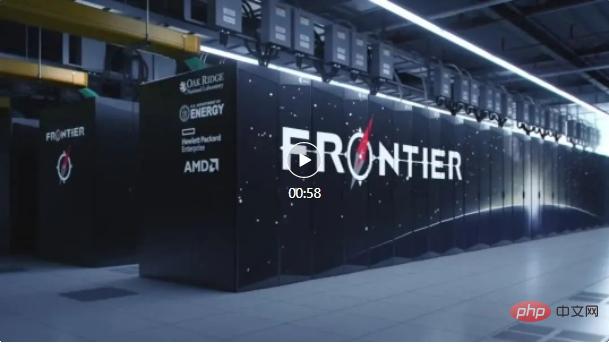
Frontier: Breaking through 10 billion times
So, how "unbelievable" has Frontier's performance been? ? ! To put it simply, even if the computing power of the 468 supercomputers behind it is added together, they cannot compare to one Frontier.
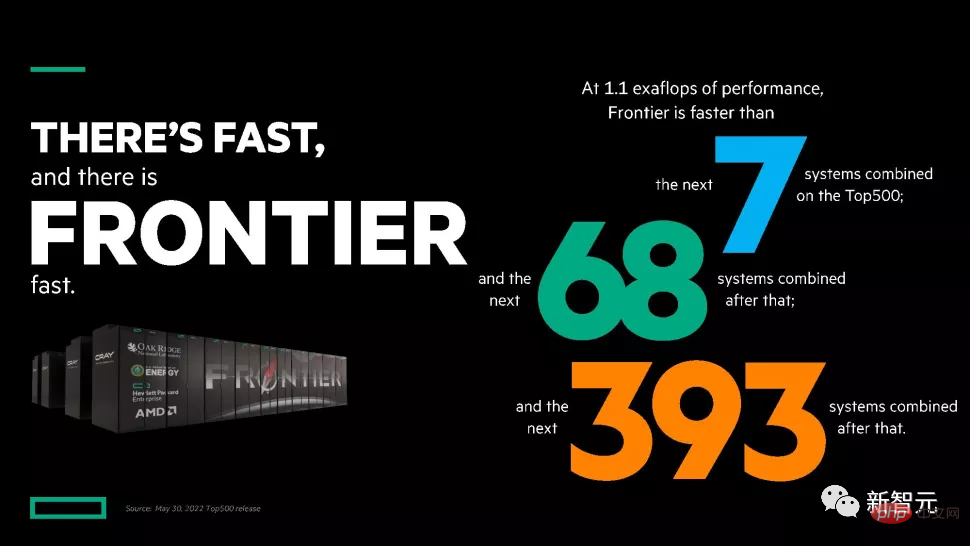
In addition to such dazzling computing power, Frontier is also one of the fastest supercomputers in the world for running AI. In the mixed precision performance test of the HPL-AI benchmark, Frontier ran a score of 6.88 ExaFlops.
In vernacular, this performance is equivalent to giving each neuron in an intelligent body composed of 86 billion neurons to issue 68 million instructions per second. Using this large model for training AI, it is like a rocket engine coupled with a Formula One car, which can take off directly on the track. The new Frontier covers an area of 372 square meters, consists of 74 HPE Cray EX cabinets, and can accommodate 9408 nodes.
Each node has an AMD Milan "Trento" 7A53 Epyc CPU, paired with 512GB DDR4 memory and 4 AMD Radeon Instinct MI250X GPUs. Overall, the system has 602,112 CPU cores connected to 4.6PB of DDR4 memory. Additionally, 37,888 AMD MI250X GPUs with 8,138,240 cores are paired with 4.6PB of HBM memory (128GB per GPU). The CPU and GPU are connected using the HPE Cray Slingshot-11 Ethernet-based network fabric.
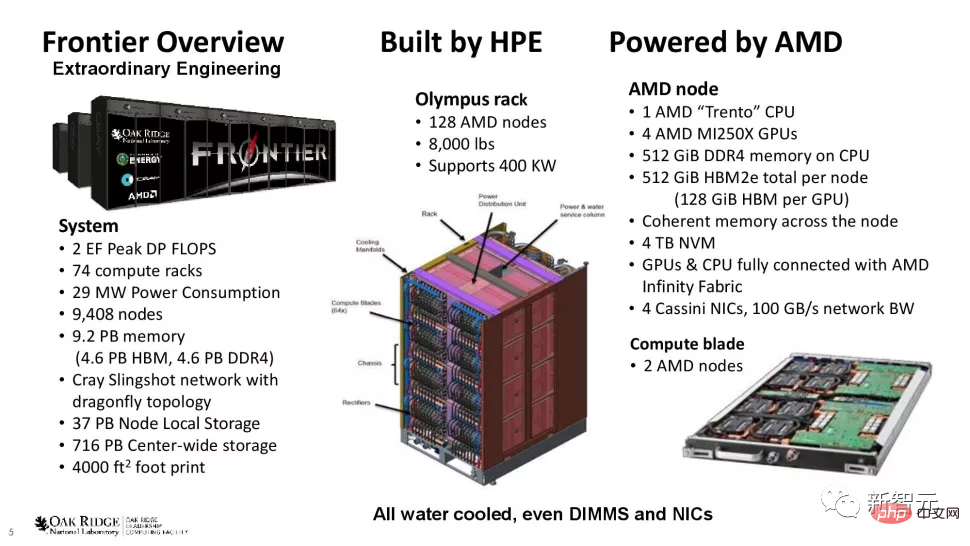
The storage is connected to an extremely high-performance storage subsystem, with a capacity of 700PB, a throughput of 75TB/s and a performance of 15 billion IOPS. The metadata layer is spread across 480 NVMe SSDs, providing 10PB of overall capacity, while 5,400 NVMe SSDs provide 11.5PB of capacity for the main high-speed storage tier. At the same time, 47,700 PMR hard drives provide 679PB of capacity.

In terms of heat dissipation, the water-cooled system allows 6,000 gallons of water to be "moved" throughout the system by a 350-horsepower pump, thus controlling the temperature at around 85 degrees. . To put it into perspective, these pumps can fill an Olympic-sized swimming pool in 30 minutes. Frontier is not only the fastest supercomputer in the world, but also the most environmentally friendly supercomputer.
Frontier’s energy consumption ratio also ranks first on the Green500 list of global supercomputer environmental protection levels. The energy consumption efficiency of a single cabinet unit composed of the third-generation AMD Epyc processor and the Instinct MI250x accelerator is 62.68 gigaflops per watt of power operations.
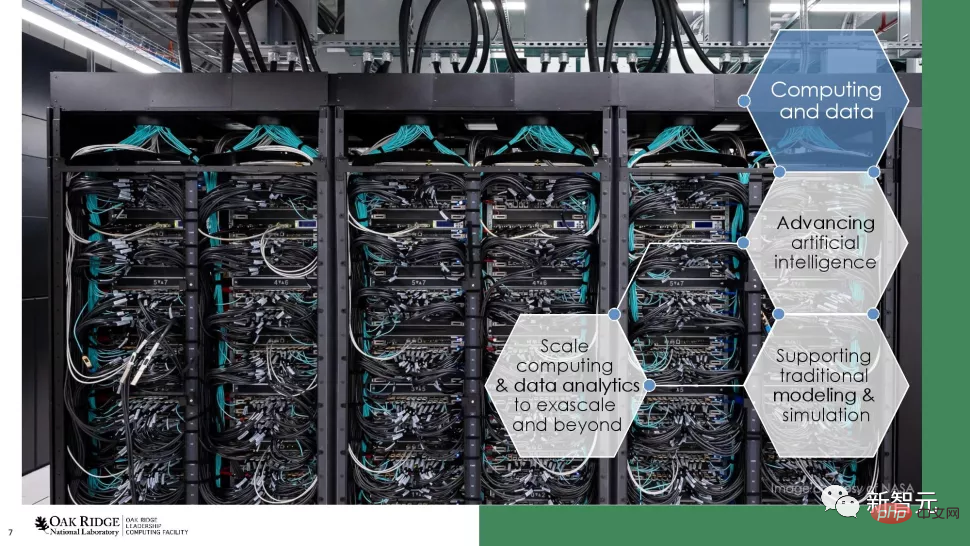
However, it is not easy to assemble Frontier. ORNL must purchase 60 million parts with 685 different numbers. In addition, we had to deal with a shortage of chips during the construction process.
ORNL has 167 affected part numbers, which works out to 2 million parts. And AMD is missing 15 numbered parts for the MI200 GPU.
So ORNL worked with ASCR to obtain a Defense Priority and Allocation System (DPAS) rating for these parts, which means that the U.S. government can use the annual defense budget to purchase them at a better price than the market price. these parts. Soon, the "shortage" problem was solved.
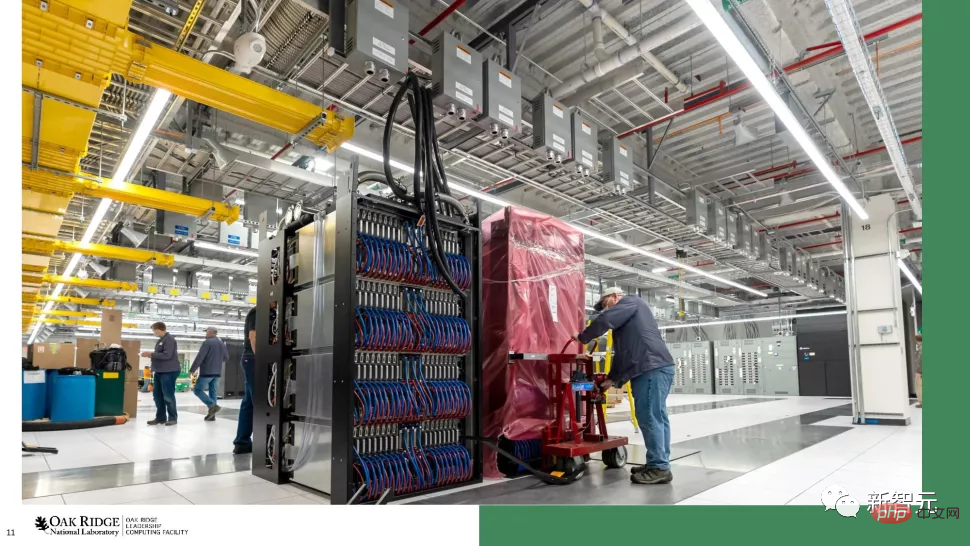
After this wave of operations, can the so-called "doubts" in many people's minds be solved? The United States: For the sake of our national defense, we will increase our efforts to develop supercomputing!
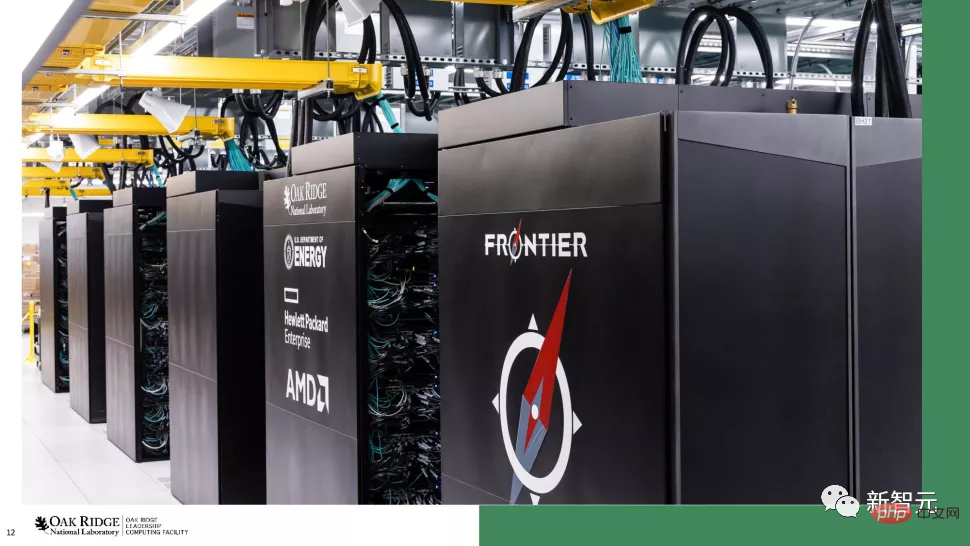
Although it costs so much, it has a wide range of uses. In an era when rich men like Nvidia are building digital twins of the earth, supercomputers in official departments of various countries are becoming more and more important in developing AI that processes huge data, simulating climate and industrial applications. Even if Oak Forest can’t use up all the computing power, it can still rent or sell it. The industry is hungry for computing power.
And there are precedents for this in other countries: In an experiment to predict the material processing results of machine tools, it took 8 hours for Japan's DMG Mori Sei Machine Tools to have its own industrial computer, but Fugaku only needed 10 minutes to complete it.
China: It’s up to you, let me take a look
In the new list, China and the United States are still the countries with the most entries.
In terms of the number of supercomputers on the list, China is still at 173, which is the same as the previous issue and continues to top the list. The United States dropped to 127 from 150 in the previous period, ranking second. Despite this, these two countries still account for 60% of the total number on the TOP 500 list. Japan, Germany, and France ranked 3-5 with 34, 31, and 22 units respectively.
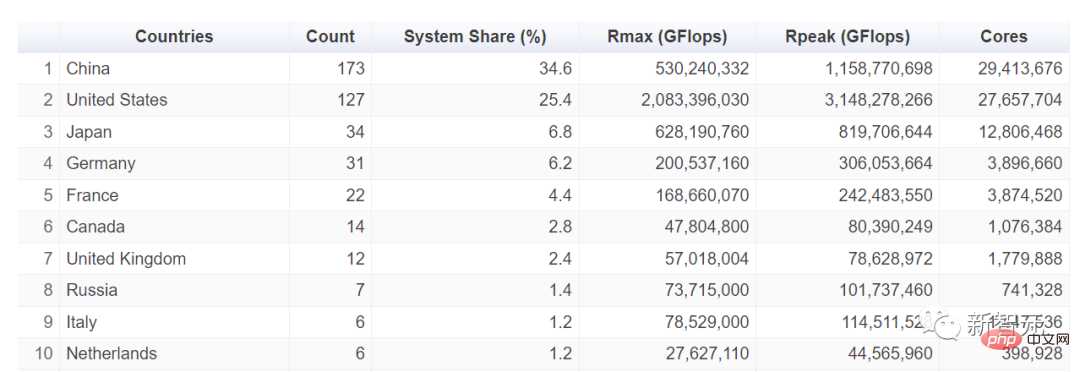
Although Frontier has officially become the most powerful supercomputer in the world, it has not been compared with the two Chinese supercomputers that were exposed last year. However, neither system currently submits test data to Top500.
According to the disclosed data, many foreign media have inferred that the peak value of Sunway OceanLight supercomputer on the HPL benchmark is about 1.3 exaflops/1.05 exaflops, while Tianhe-3 can reach 1.7 exaflops peak value/1.3 exaflops sustained value. However, considering the various "stuck necks" in the United States on chips, the consequences of China's supercomputing rankings are likely to become a "target" for sanctions. Presumably, we will not see any relevant data in the short term. updated.

In terms of the number of entries on the list, China occupies the top spot with a proportion of 34.6%, and the United States ranks second with a proportion of 25.4%. China and the United States still compete for hegemony.
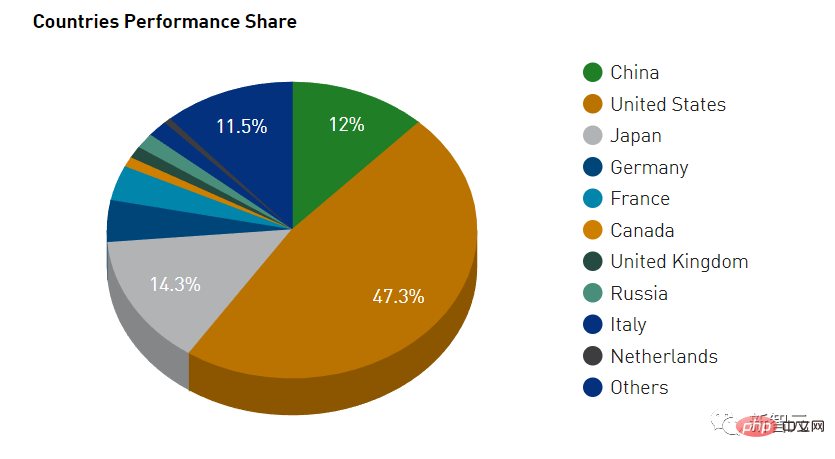
In the overall performance rankings, the United States’ advantage is still unshakable, firmly occupying the first place with 47.3% of the total computing power. It is not difficult to see that the number of people who have reached the top this time is Frontier has contributed a lot to the stable dominance of the United States.
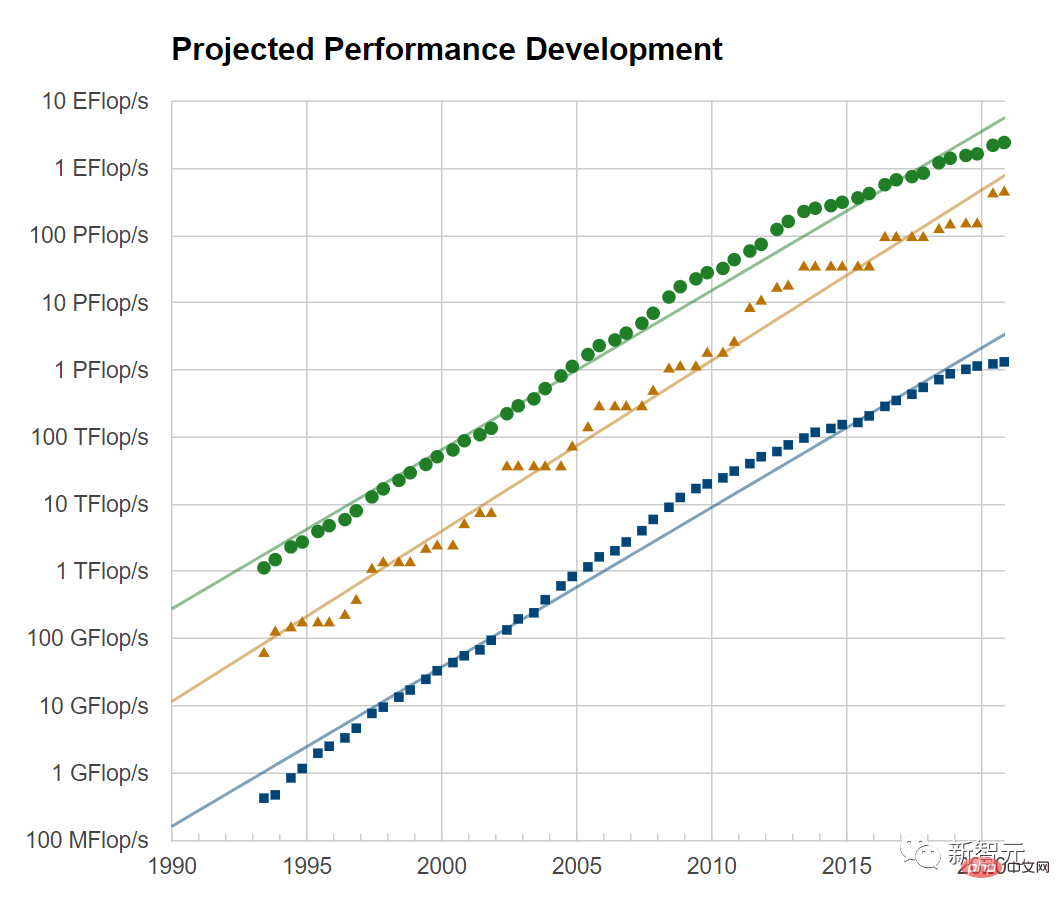
In addition, this Top 500 list also counts the progress of supercomputing power since 1990, and conducts linear regression. The horizontal axis in the table is time, and the vertical axis is computing power (taken as a logarithm).
The green dot is the total computing power of the supercomputer on the list, the yellow triangle is the computing power of the top supercomputer on the list, and the blue square is the computing power of the last (500th) supercomputer on the list. The straight lines of corresponding colors are the results of linear regression. It can be seen that these three straight lines are roughly in line with Moore's Law's predictive judgment on the increase in computing power. It is said that Moore's Law is dead, but it seems that in the field of supercomputing, it is still alive and well.
The Rise of Europe: Top 10 occupies 7 seats
The United States is not the only region that has achieved remarkable results. Europe also performed well. From the overall ranking, the United States, China, and Japan occupy the top three, and the remaining seven seats in the top ten are all occupied by European countries.
Among them, 31 German stations are on the list, 22 French stations are on the list, and 14 Italian stations are on the list. Finland's newly deployed LUMI supercomputer barely surpassed the United States' Summit with an FP64 performance of 151.9 petaflops, ranking third.
In addition, France’s GENCI-CINES’ Adastra almost won the 10th place with a performance of 46.1 petaflops. Although nowhere near as powerful as LUMI, Adastra still retains the distinction of being the second most powerful supercomputer in Europe. Systems such as LUMI and Adastra also illustrate another trend. Like Frontier, they're based on HPE's all-AMD Cray EX platform, using third-generation Epyc CPUs and Instinct GPUs.
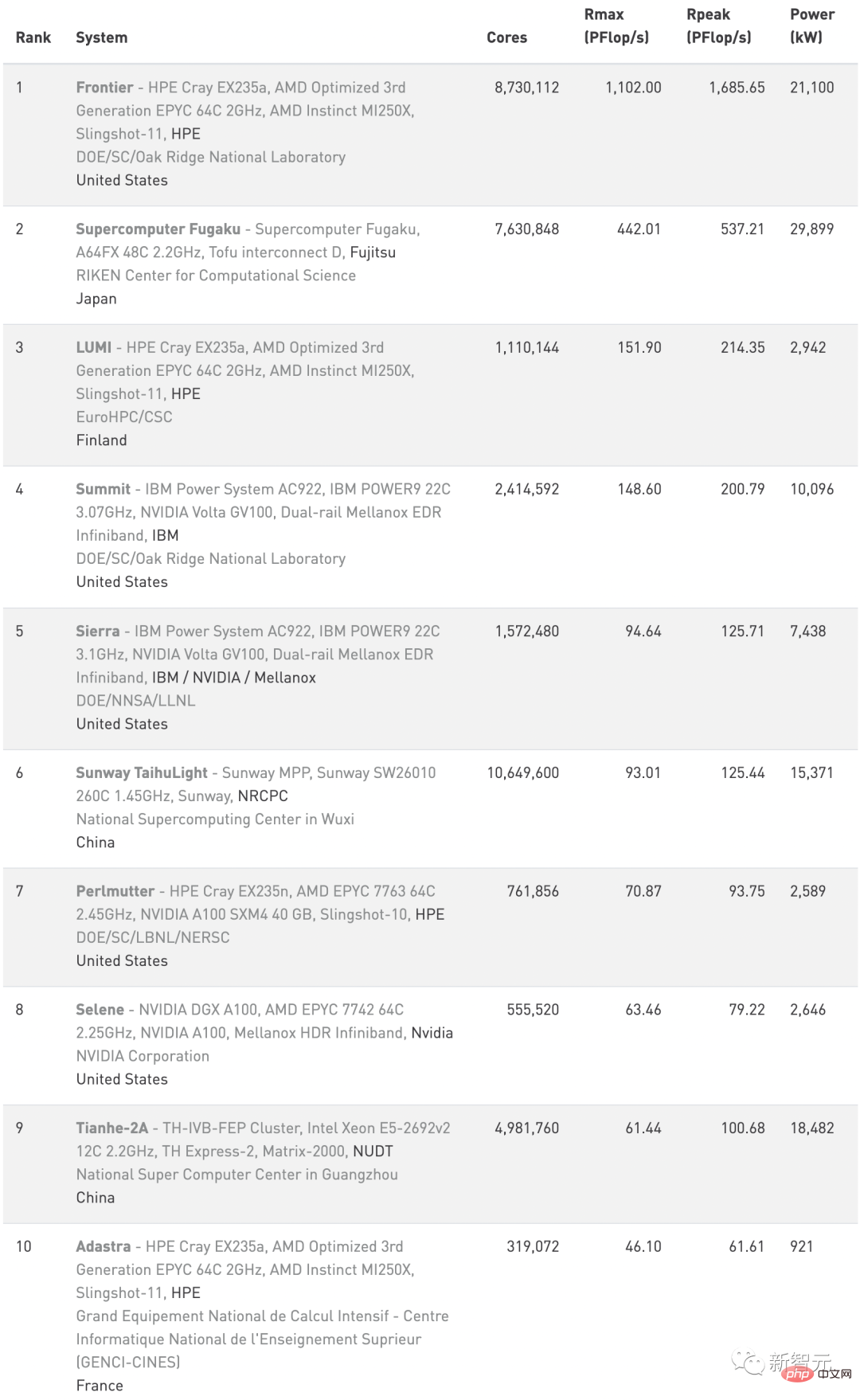
Why not use GPU acceleration: it’s still a waste of money
For the first time in a long time, AMD is represented among the host CPUs in the system in the Top500 share, but Intel Xeon processors still dominate.
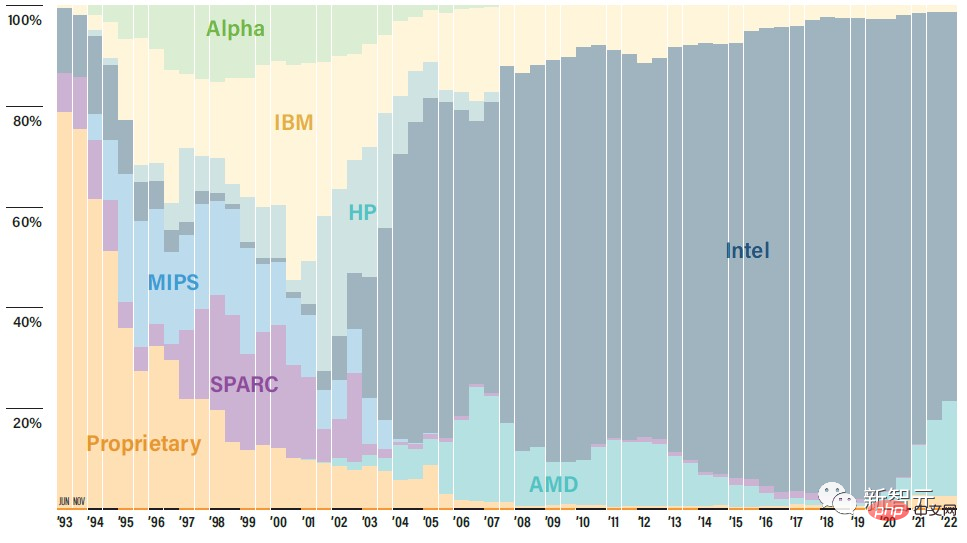
Since the beginning of this century, Intel has begun to develop its efforts in the field of high-performance computing. In just a few years, it has defeated several previous major players such as IBM and Hewlett-Packard. I was so squeezed out that I lost my vitality. From 2017 to 2020, Intel's market share in the field of high-performance computing reached its peak, once exceeding 90%.
Until now, Intel's share is still as high as 77.4%, a decrease of 4.2 percentage points, while AMD's share has just increased by this number. Epycs is expected to gain more momentum against the Xeon SP. Moreover, AMD has the momentum to catch up from behind. In the 2022 Global Supercomputing Top500 list, there are now 94 supercomputers relying on AMD products, an annual increase of 95%. Moreover, AMD’s Instinct MI200 accelerator is used in 7 of the supercomputers for the first time.
Another question is, why not use GPU accelerator? Maybe because it's expensive? As a computing engine, GPU accelerators can improve huge performance and cost-effectiveness. However, currently, accelerators do not occupy a dominant position among the supercomputing architectures on the Top500 list. These GPU accelerators are mainly from Nvidia. However, in addition to NVIDIA's own HPC center, which has a large number of applications that need to be ported to GPUs and is not short of money, thousands of other HPC centers around the world are still short of money. The code of these HPCs is explicitly written for CPUs.
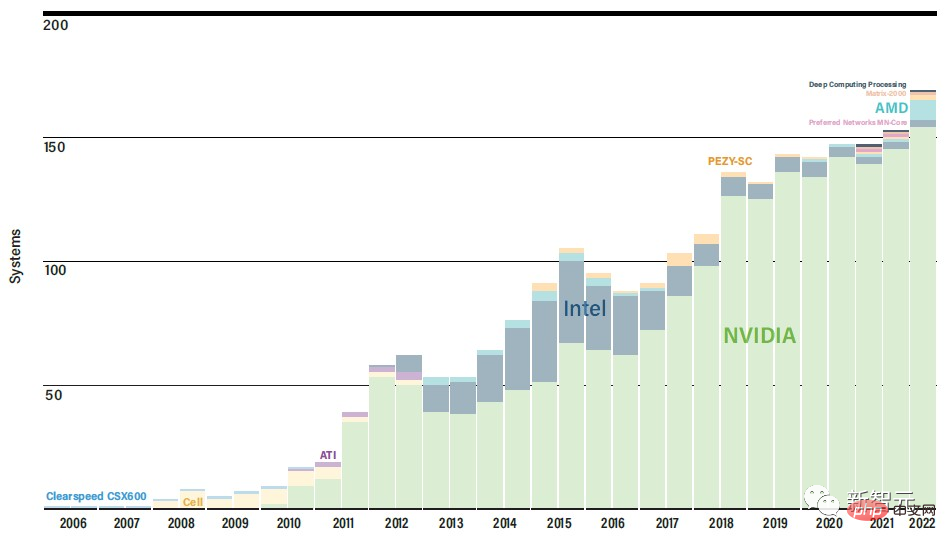 On the current Top500 list, only 170 supercomputers use GPU accelerators - of course most of them are from NVIDIA. Another factor is that cheaper CPUs themselves are now adding accelerated computing functions similar to GPUs, such as vector and now matrix calculations.
On the current Top500 list, only 170 supercomputers use GPU accelerators - of course most of them are from NVIDIA. Another factor is that cheaper CPUs themselves are now adding accelerated computing functions similar to GPUs, such as vector and now matrix calculations.
This saves money and is easier to program than transferring CPU programs to GPU. We may never see a Top500 list consisting primarily of GPU-accelerated systems. In fact, in top-ranked supercomputing systems such as "Fuyue" and "TaihuLight", the CPU basically acts as a GPU with vector and matrix calculations.
The above is the detailed content of The United States regains the top spot in supercomputing in the world! Humanity has achieved exascale supercomputing, and Frontier has killed the top 500 companies in the world.. For more information, please follow other related articles on the PHP Chinese website!

Hot AI Tools

Undresser.AI Undress
AI-powered app for creating realistic nude photos

AI Clothes Remover
Online AI tool for removing clothes from photos.

Undress AI Tool
Undress images for free

Clothoff.io
AI clothes remover

AI Hentai Generator
Generate AI Hentai for free.

Hot Article

Hot Tools

Notepad++7.3.1
Easy-to-use and free code editor

SublimeText3 Chinese version
Chinese version, very easy to use

Zend Studio 13.0.1
Powerful PHP integrated development environment

Dreamweaver CS6
Visual web development tools

SublimeText3 Mac version
God-level code editing software (SublimeText3)

Hot Topics
 1386
1386
 52
52
 Italian energy giant Eni will build a new generation of supercomputer HPC6: AMD CPU + GPU, which is expected to rank among the top five in the world in computing power
Jan 31, 2024 pm 03:03 PM
Italian energy giant Eni will build a new generation of supercomputer HPC6: AMD CPU + GPU, which is expected to rank among the top five in the world in computing power
Jan 31, 2024 pm 03:03 PM
According to news from this website on January 30, Italian energy giant Eni Group recently announced that it will build a new HPC6 supercomputer. The supercomputer will be built based on AMDEPY CCPU and InstinctMI250XGPU. When completed, the theoretical peak computing power will reach 600PFlop/s, and the sustained peak computing power will also be 400PFlop/s, ranking fifth in the existing Top500 list. After inquiry, we learned that Eni is one of the world's traditional large oil companies and one of the three largest companies in Italy. It is understood that the company is approximately 30% owned by the Italian government. ▲Photos of the previous generation HPC5 supercomputer. Source: Eni Group official website Eni Group’s current two supercomputers have entered the Top500 supercomputer list: the previous
 PHP implements popular ranking function
Jun 23, 2023 am 11:32 AM
PHP implements popular ranking function
Jun 23, 2023 am 11:32 AM
With the rapid development of the Internet, the number of users faced by websites is also growing. For large websites, how to implement the popular ranking function is a very important issue. Popular rankings allow users to easily view the most popular content, and can also be of great help to website promotion and traffic growth. This article will introduce how to use PHP to implement the popular ranking function. Determining the indicators of popular rankings Before implementing the popular ranking function, we need to determine the indicators of popular rankings. Indicators can be clicks, page views, collections
 UC Berkeley LLM quasi-Chinese rankings are here! GPT-4 ranks first, and the Chinese open source RNN model breaks into the top six
May 16, 2023 pm 10:43 PM
UC Berkeley LLM quasi-Chinese rankings are here! GPT-4 ranks first, and the Chinese open source RNN model breaks into the top six
May 16, 2023 pm 10:43 PM
Some time ago, researchers from LMSYSOrg (led by UC Berkeley) made big news - the large language model version of the ranking competition! This time, the team not only brings 4 new players, but also a (quasi) Chinese leaderboard. OpenAIGPT-4OpenAIGPT-3.5-turboAnthropicClaude-v1RWKV-4-Raven-14B (open source) There is no doubt that as long as GPT-4 participates in the war, it will definitely rank first. However, unexpectedly, Claude not only ranked second than GPT-3.5, which brought OpenAI to the altar, but was only 50 points worse than GPT-4. In comparison, the third-ranked GPT-3.5 is only 13
 AIRankings world university AI rankings released
Apr 09, 2023 pm 07:21 PM
AIRankings world university AI rankings released
Apr 09, 2023 pm 07:21 PM
It’s the college entrance examination season again. I remember that when I was taking the college entrance examination, this sentence was popular. That is, "Look at the school for undergraduates, and the major for graduate school." There may have been nothing wrong with what I said before. However, with the rapid development of science and technology in recent years, some majors related to front-end technology may start from the undergraduate level. The most popular major at the moment is artificial intelligence. It just so happened that AIRankings recently released a ranking of AI-related majors in global universities. Let’s take a look at which universities and institutions are on the list. AI World Ranking: The top three AIRankings rankings in Beiqing combine research over the past ten years, as well as general artificial intelligence, computer vision, robotics, machine learning, natural language processing, cognitive reasoning, and multi-intelligence
 AMD graphics card performance ranking in 2020
Jan 13, 2024 pm 08:54 PM
AMD graphics card performance ranking in 2020
Jan 13, 2024 pm 08:54 PM
amd graphics card ranking 1. What needs to be rewritten for Radeon is: RX. What needs to be rewritten for Radeon is: 6950XT2. What needs to be rewritten for Radeon is: RX. What needs to be rewritten is: 6900XT. 3. Radeon What needs to be rewritten is: RX What needs to be rewritten is: 6800XT4, Radeon What needs to be rewritten is: RX What needs to be rewritten is: 6800 What needs to be rewritten is: 5. Radeon needs to be rewritten: What needs to be rewritten for RX is: 6750XT6, what needs to be rewritten for Radeon is: what needs to be rewritten for RX is: 6700XT7
 The number is 30 times that of the most powerful supercomputer on the planet. AMD's trump card against NVIDIA: 1.2 million GPUs form an AI cluster.
Jun 26, 2024 pm 04:32 PM
The number is 30 times that of the most powerful supercomputer on the planet. AMD's trump card against NVIDIA: 1.2 million GPUs form an AI cluster.
Jun 26, 2024 pm 04:32 PM
According to news from this site on June 26, the world’s most powerful supercomputers are equipped with less than 50,000 powerful GPUs. In order to enhance its competitiveness with Nvidia, AMD aims to launch a super data center AI cluster that supports 1.2 million GPUs. . In an interview with TheNextPlatform, Forrest Norrod, executive vice president and general manager of AMD's Data Center Solutions Group, said that the company is seriously considering building the largest artificial intelligence GPU cluster. Note from this site: Artificial intelligence training clusters are usually built with thousands of GPUs, connected to server racks through high-speed interconnects. The 1.2 million chips AMD is researching will undoubtedly increase exponentially in order of magnitude, which will inevitably bring about delays, power consumption, Hardware failure and many other aspects
 How to check the listening music rankings on Kugou Music. How to check the listening music rankings on Kugou Music.
Mar 16, 2024 pm 01:04 PM
How to check the listening music rankings on Kugou Music. How to check the listening music rankings on Kugou Music.
Mar 16, 2024 pm 01:04 PM
Kugou Music is a playback software with a large amount of music. In Kugou Music, users listen to music every day. Whether they are riding in the car, playing, working, etc., they wear headphones to listen to music. Listening to music is always useful. The duration will also be recorded in great detail. Some friends want to know how long they have listened to the song. How can I check this? Friends who want to know, please come to this website. Read the prepared guide in , the memory is very detailed, let’s take a look. How to check the listening song rankings on Kugou Music 1. Enter the Kugou Music software and click the [My] option in the lower right corner; 2. Then click to open your [Avatar] on my page; 3. Then enter Go to your personal home page and click [Listening to Songs Ranking]
 NVIDIA helps Japan build hybrid supercomputing: more than 2,000 H100 Tensor Core GPUs
Apr 25, 2024 pm 06:25 PM
NVIDIA helps Japan build hybrid supercomputing: more than 2,000 H100 Tensor Core GPUs
Apr 25, 2024 pm 06:25 PM
According to news from this website on April 25, NVIDIA recently announced that it is cooperating with Japan's Institute of Advanced Industrial Science and Technology (AIST) to build a supercomputer called "ABCI-Q", which will integrate traditional supercomputers and quantum computers to create a hybrid cloud system. Because Nvidia says quantum calculators running alone will still make a lot of mistakes, supercomputers must help resolve errors and make complex calculations smoother. ABCI-Q+%’s ability to perform high-speed, complex calculations will help research and enterprise applications in the fields of artificial intelligence, energy and biotechnology, such as improving the efficiency of new drug development and logistics. The website learned from reports that ABCI-Q+ has more than 2,000 Nvidia H100TensorCore GPUs built in, and is



